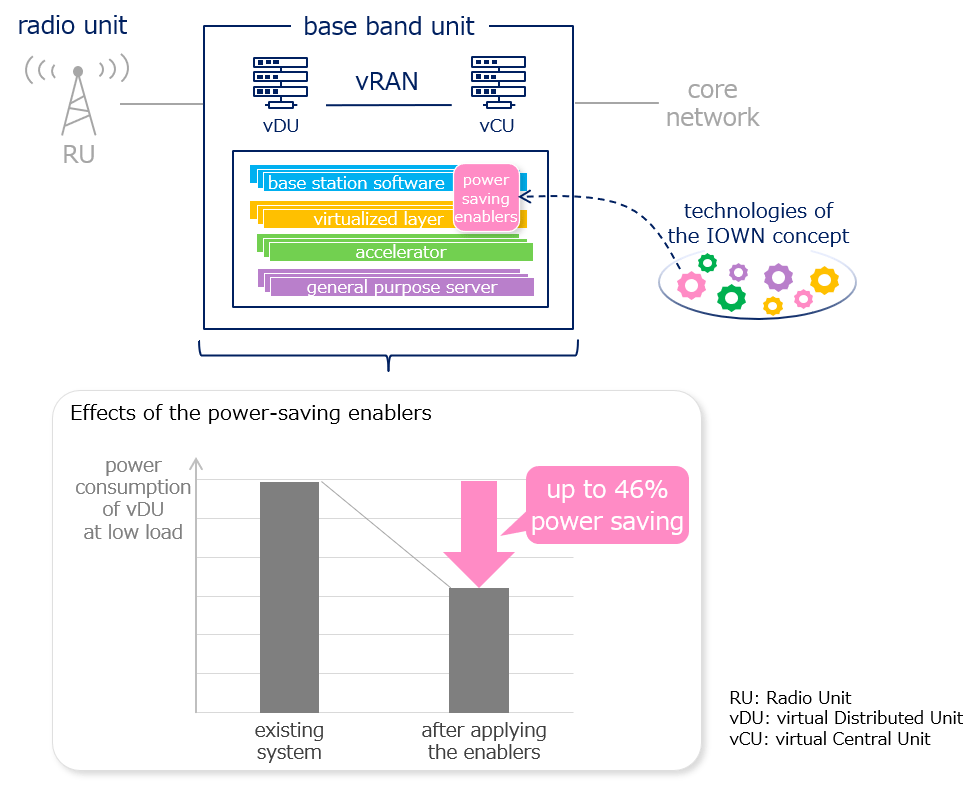NTT succeeded in low-power consumption of 5G virtualised radio base station (vRAN)
NTT Corporation (Headquarters: Chiyoda-ku, Tokyo, President & CEO: Akira Shimada, "NTT") demonstrated that power-saving enablers, technologies developed through NTT's research, can reduce power consumption of software-based virtualised base stations by up to 46% in an environment similar to an actual commercial network.
These power-saving enablers are planned to be incorporated into vendor's commercial virtualised base stations and be provided globally, contributing to the development of a sustainable society by helping telecommunications operators decarbonise.
1. Background
With the performance improvement of general-purpose CPUs and the evolution of softwarisation and virtualisation technologies for network functions, research and practical use of virtualised base stations have recently been attracting attention. Virtualised base stations are also called a virtual radio access network (vRAN), in which wireless base station functions are composed of software on a general-purpose server. Since virtualised base stations are deployed on general-purpose servers, they have the advantage of significantly reducing capital expenditure compared with dedicated hardware.
On the other hand, compared with dedicated hardware optimised for wireless base stations, general-purpose servers have inefficiencies associated with general-purpose processing. Thus, power consumption of virtualised base stations needs to be reduced. In general, there is a trade-off between performance improvement and power consumption reduction. Thus, achieving both in virtualised base stations is particularly difficult since base stations have microsecond-order latency requirements. Therefore, a solution to this problem has been sought.
2. Overview
NTT is researching and developing various technologies, including innovative technologies centered on optics, to realise the IOWN concept*1. As part of this effort, NTT is researching power-saving enablers that can be incorporated into software and achieve power saving. The power-saving enablers can be used in use cases with strict latency requirements.
2.1 Power saving enablers
The power-saving enablers are based on the concept of controlling software processing so that it is performed with the minimum computing resources required for a given workload, and they achieve a significant power-saving effect, especially at low loads. NTT started researching the power-saving enablers focusing on the aforementioned issue of reducing power consumption of virtualised base stations, analysed each of their software process from a power consumption perspective, devised multiple technologies to improve inefficient processing, and demonstrated that the power-saving enablers can reduce power consumption of virtualised base stations without degradation performance. The software technologies of the power-saving enablers will enable greater power-saving effects by cooperating with "photonics-electronics convergence technologies," "all photonics network (APN)*2," and "super white box*3," which NTT is researching and developing to realise of the IOWN concept.
 Figure 1: Overview of the power-saving enablers
Figure 1: Overview of the power-saving enablers
2.2 Technology demonstration experiment
For technology demonstration experiments, the power-saving enablers were incorporated into actual virtualised base stations provided by Fujitsu Limited to evaluate their effectiveness in an environment similar to an actual commercial network. As a first step, the effectiveness of the following power-saving enablers was demonstrated: (1) sleep-control technology of software processing under strict delay requirements, (2) flexible-scaling control technology of devices required for processing, and (3) control technology that maximises power-saving functions of devices. These enablers were incorporated into products with two types of architecture (look-aside model*4 and in-line model*4), which are the mainstream in virtualised base stations. They were evaluated on a current general-purpose server and found to reduce power consumption by up to 46% under low traffic conditions.
3. Future plans
The power-saving enablers are planned to be licensed to vendors who need to utilise them. By globally providing these power-saving enablers through incorporating them into vendors' virtualised base stations, NTT will support decarbonisation of telecommunications operators through power saving in 5G/6G networks, etc., with the aim of realising a sustainable society. In addition, NTT will continue to research and develop power-saving technologies to realise the IOWN concept, thereby contributing to power saving across society as a whole.



